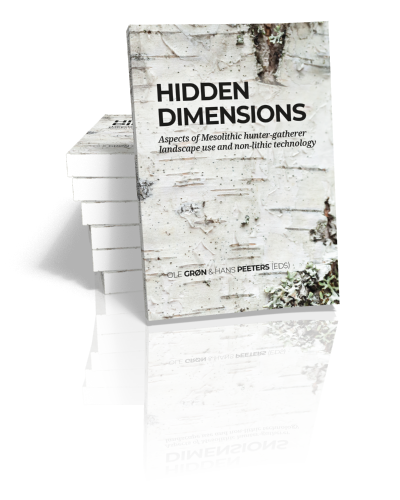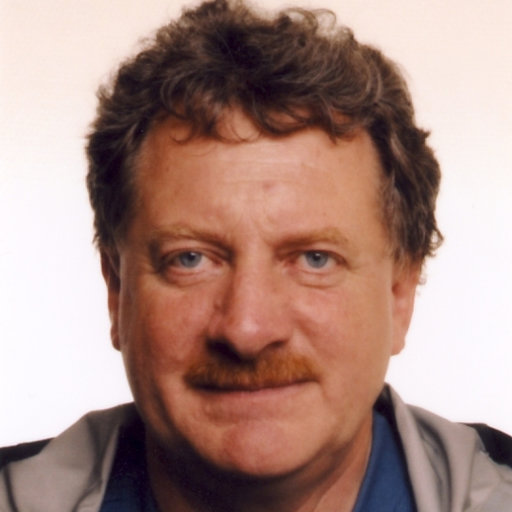Hidden dimensions
Aspects of Mesolithic hunter-gatherer landscape use and non-lithic technology
Edited by Ole Grøn & Hans Peeters | 2022

Hidden dimensions
Aspects of Mesolithic hunter-gatherer landscape use and non-lithic technology
Edited by Ole Grøn & Hans Peeters | 2022
Paperback ISBN: 9789464261257 | Hardback ISBN: 9789464261264 | Imprint: Sidestone Press | Format: 182x257mm | 260 pp. | Language: English | 22 illus. (bw) | 62 illus. (fc) | Keywords: mesolithic; hunter-gatherers; hunting; dwellings; pitfalls; landscape use; lithics; non-lithic technology; clothing; labour division | download cover
Read online 386 times
- Digital & Online access
-
Buy via Sidestone (EU & UK)
-
Buy via our Distributors (WORLD)
For non-EU or UK destinations you can buy our books via our international distributors. Although prices may vary this will ensure speedy delivery and reduction in shipping costs or import tax. But you can also order with us directly via the module above.
UK international distributor
USA international distributor
-
Bookinfo
Paperback ISBN: 9789464261257 | Hardback ISBN: 9789464261264 | Imprint: Sidestone Press | Format: 182x257mm | 260 pp. | Language: English | 22 illus. (bw) | 62 illus. (fc) | Keywords: mesolithic; hunter-gatherers; hunting; dwellings; pitfalls; landscape use; lithics; non-lithic technology; clothing; labour division | download cover
Read online 386 times

We will plant a tree for each order containing a paperback or hardback book via OneTreePlanted.org.
The modelling and representation of prehistoric hunter-gatherer behaviours is largely influenced by the investigation of sites with high archaeological visibility, due to the presence of large amounts of knapped lithics, which generally survive the ravages of time. As a consequence, behaviours which were not, or to a limited extent, associated with stone tools are underrepresented in archaeological narratives about hunter-gatherer lifestyles, which, however, have characterised most of the human past. Occasionally, at sites where preservation conditions are good, archaeological finds point to the importance of organic resources for tools and the manufacturing of a broad range of use items, such as clothing, footwear, containers, as well as tent covers and mats. In fact, it is highly likely that organic materials – e.g. wood, bark, bone, antler, hide – were dominant in the creation of material culture, and possibly played a pivotal role in sociocultural communication.
The lack of attention for sites and phenomena associated with no or few lithics causes several problems with regard to archaeological insights into the variability in landscape use, technological traditions, and sociocultural interaction. This book presents a collection of articles which address these problems from several angles, with an emphasis on the Mesolithic of NW Europe: dwellings and activities associated with no or few lithics; variability in site location and landscape use, notably in relation to hunting and ethology of game species; and technological aspects of non-lithic material culture. The book intends to increase awareness of the consequences of the issues addressed for our understanding of the past, and boost research and heritage management initiatives in this field.
Introduction
Cultural dynamics in Stone Age hunter-gatherer lifeways. Hidden dimensions
Ole Grøn & Hans Peeters
Part 1 – Dwellings with no or little knapped lithics
A Mesolithic bark mat on Kvitsøy in south-western Norway
Sigrid Alræk Dugstad
No knapping on the floor! Norwegian examples of (mainly) Mesolithic dwellings with few associated lithics
Silje Fretheim
Part 2 – Sites in the landscape with no or little knapped lithics.
Mesolithic sites with no or few finds: some examples from the west coast of Sweden
Robert Hernek
Dozens of large and (almost) empty pits. Towards a new geography for the French Mesolithic?
Nathalie Achard-Corompt, Emmanuel Ghesquière, Christophe Laurelut, Charlotte Leduc, Arnaud Rémy, Isabelle Richard, Vincent Riquier, Luc Sanson & Julia Wattez
Mesolithic Landscapes and where to hunt the big game: everywhere, or ???
David Vogt, Ole Grøn, Hans Peeters, Robert Hernek & Eva David
Part 3 – Non-lithic material culture.
What is not there? Skin and fur objects in prehistoric hunter-gatherer societies
Torunn Klokkernes
Thin and spiky: eyed needles, sharp awls (a case study on materials from the Upper Palaeolithic Yana site, Arctic Siberia)
Vladimir V. Pitulko & Elena Y. Pavlova
Bone flakes from traditional metapodial reduction in postglacial deposits
Éva David, Arturo Cueva Temprana & Justyna Orłovska

Dr. Ole Grøn
Ole Grøn is a researcher at the Department of Geosciences and Natural Resource Management, University of Copenhagen. He has a wide experience in the field of maritime archaeology, ethnoarchaeology, and landscape archaeology. He is particularly focussed on the archaeology of Stone Age hunter-gatherers, and has conducted extensive ethnoarchaeological research among the Siberian Evenk. Next to the development of insights into hunter-gatherer lifeways, he has a keen interest in the methodological issues in the detection of hunter-gatherer settlement remains and the representation of hunter-gatherers based on the flawed archaeological record. Currently he is concerned with the development of acoustic survey methods for underwater archaeology, with an emphasis on submerged Stone Age sites.

Dr. Hans Peeters
Hans Peeters is associate professor at the Groningen Institute of Archaeology, University of Groningen. He obtained his PhD from the University of Amsterdam. As a specialist in the archaeology of hunter-gatherers and early farmers, he worked at the Dutch Cultural Heritage Agency from 1997 till 2009, and was involved in various projects, notably in Flevoland. In his work, he focusses on the relationship between landscape dynamics and hunter-gatherer behaviour.
Abstract:
The modelling and representation of prehistoric hunter-gatherer behaviours is largely influenced by the investigation of sites with high archaeological visibility, due to the presence of large amounts of knapped lithics, which generally survive the ravages of time. As a consequence, behaviours which were not, or to a limited extent, associated with stone tools are underrepresented in archaeological narratives about hunter-gatherer lifestyles, which, however, have characterised most of the human past. Occasionally, at sites where preservation conditions are good, archaeological finds point to the importance of organic resources for tools and the manufacturing of a broad range of use items, such as clothing, footwear, containers, as well as tent covers and mats. In fact, it is highly likely that organic materials – e.g. wood, bark, bone, antler, hide – were dominant in the creation of material culture, and possibly played a pivotal role in sociocultural communication.
The lack of attention for sites and phenomena associated with no or few lithics causes several problems with regard to archaeological insights into the variability in landscape use, technological traditions, and sociocultural interaction. This book presents a collection of articles which address these problems from several angles, with an emphasis on the Mesolithic of NW Europe: dwellings and activities associated with no or few lithics; variability in site location and landscape use, notably in relation to hunting and ethology of game species; and technological aspects of non-lithic material culture. The book intends to increase awareness of the consequences of the issues addressed for our understanding of the past, and boost research and heritage management initiatives in this field.
Contents
Introduction
Cultural dynamics in Stone Age hunter-gatherer lifeways. Hidden dimensions
Ole Grøn & Hans Peeters
Part 1 – Dwellings with no or little knapped lithics
A Mesolithic bark mat on Kvitsøy in south-western Norway
Sigrid Alræk Dugstad
No knapping on the floor! Norwegian examples of (mainly) Mesolithic dwellings with few associated lithics
Silje Fretheim
Part 2 – Sites in the landscape with no or little knapped lithics.
Mesolithic sites with no or few finds: some examples from the west coast of Sweden
Robert Hernek
Dozens of large and (almost) empty pits. Towards a new geography for the French Mesolithic?
Nathalie Achard-Corompt, Emmanuel Ghesquière, Christophe Laurelut, Charlotte Leduc, Arnaud Rémy, Isabelle Richard, Vincent Riquier, Luc Sanson & Julia Wattez
Mesolithic Landscapes and where to hunt the big game: everywhere, or ???
David Vogt, Ole Grøn, Hans Peeters, Robert Hernek & Eva David
Part 3 – Non-lithic material culture.
What is not there? Skin and fur objects in prehistoric hunter-gatherer societies
Torunn Klokkernes
Thin and spiky: eyed needles, sharp awls (a case study on materials from the Upper Palaeolithic Yana site, Arctic Siberia)
Vladimir V. Pitulko & Elena Y. Pavlova
Bone flakes from traditional metapodial reduction in postglacial deposits
Éva David, Arturo Cueva Temprana & Justyna Orłovska

Dr. Ole Grøn
Ole Grøn is a researcher at the Department of Geosciences and Natural Resource Management, University of Copenhagen. He has a wide experience in the field of maritime archaeology, ethnoarchaeology, and landscape archaeology. He is particularly focussed on the archaeology of Stone Age hunter-gatherers, and has conducted extensive ethnoarchaeological research among the Siberian Evenk. Next to the development of insights into hunter-gatherer lifeways, he has a keen interest in the methodological issues in the detection of hunter-gatherer settlement remains and the representation of hunter-gatherers based on the flawed archaeological record. Currently he is concerned with the development of acoustic survey methods for underwater archaeology, with an emphasis on submerged Stone Age sites.

Dr. Hans Peeters
Hans Peeters is associate professor at the Groningen Institute of Archaeology, University of Groningen. He obtained his PhD from the University of Amsterdam. As a specialist in the archaeology of hunter-gatherers and early farmers, he worked at the Dutch Cultural Heritage Agency from 1997 till 2009, and was involved in various projects, notably in Flevoland. In his work, he focusses on the relationship between landscape dynamics and hunter-gatherer behaviour.
- Digital & Online access
-
Buy via Sidestone (EU & UK)
-
Buy via our Distributors (WORLD)
For non-EU or UK destinations you can buy our books via our international distributors. Although prices may vary this will ensure speedy delivery and reduction in shipping costs or import tax. But you can also order with us directly via the module above.
UK international distributor
USA international distributor
- Browse all books by subject
-
Search all books

We will plant a tree for each order containing a paperback or hardback book via OneTreePlanted.org.
© 2026 Sidestone Press KvK nr. 28114891 Privacy policy Sidestone Newsletter Terms and Conditions (Dutch)





